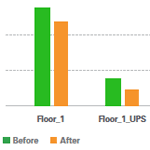HVAC retrofit helps school achieve climate neutrality goals.
“As UC Berkeley continues to implement projects that reduce our energy usage and greenhouse gas emissions, we will look to replicate the success of this project in achieving large savings through an approach tailored to the specific needs of the building.”
– Lisa McNeilly, Director, UC Berkeley Office of Sustainability
The University of California, Berkeley is setting a high standard with its goal of achieving climate neutrality. The ventilation system retrofit at University Hall is one example of the many steps the campus is taking toward reducing its impact on the climate.
Through a campus-wide, monitoring-based commissioning effort, engineers discovered that portions of University Hall were frequently over ventilated, wasting both electricity and natural gas. To address these inefficiencies, the engineers recommended a Vigilent system to increase the ventilation system’s operating efficiency.
The Vigilent system saves energy by retrofitting a constant air volume (CAV) ventilation system to approximate a variable air volume (VAV) system using variable frequency drives and a wireless communication system to reduce fan speeds to match demand.
The $176,000 total project cost for University Hall was relatively low because retrofitting the two zones (about 127,000 square feet of building space) only required the purchase and installation of seven VFDs and six motors. Installation of the VFDs, motors and Vigilent components at University Hall was quick, taking about one month.



